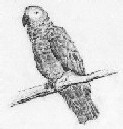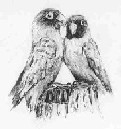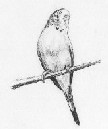The Parrot Family: General Information
See also:
 Books
on birds Books
on birds
 Bird
watching holidays Bird
watching holidays
 News and research for more
information on parrots and other birds News and research for more
information on parrots and other birds
  
The parrot family includes a wide range of birds from different continents,
such as budgies and cockatiels, both parakeet species from Australia, lovebirds
and African Grey parrots from Africa, and Macaws from Latin America. This
family has a number of characteristics in common, like strong beaks, and big
heads.
Parrots are also skilled mimics, and even the smaller parakeets, like
budgies, can learn to say a few words and whistle some tunes. One of my cockatiels
learnt to imitate the telephone so well he fooled me several times into thinking
the phone was really ringing. He would also wolf whistle, and do a very good
imitation of me shouting 'get down' (to the cats), as well as creaking like
one of my doors, long after it had been oiled and no longer creaked. The ability
of African Grey parrots to talk was mentioned by the Ancient Greeks, and they
have the greatest ability to develop a repertoire. The best results for all
species come from birds trained young, though African Greys seem to need little
training, they just love being mimics.
Differences between parrot species
Parrots vary in terms of diet, with some needing more fresh fruit than others, and a few species living on nectar. They vary in terms of how long they live, for example, budgies live from five to 10 years, cockatiels from between 10-15 years, and some larger species can easily outlive their owners. All parrots are social birds, but some species are more peaceful than others. Budgies and cockatiels live in groups of up to several hundred in their natural habitat. They can be kept in groups if you have enough room, whereas lovebirds are best kept in pairs, and African Greys are best kept alone, or in pairs. Parrots should only be kept singly if you are prepared to devote a lot of time to your bird, as they can suffer from loneliness and boredom if left alone.
Housing
The size of the cage or aviary affects the relationships of the birds kept inside it. Birds are more likely to bully or be bullied if they don't have enough room.
Cages should always be big enough for the bird to move around comfortably and extend its wings fully, if you just keep one bird, and to allow the inhabitants space away from each other, if you keep more than one. Cages should be rectangular, not round - as birds don't generally feel safe or comfortable in round cages.
Perches provided with the cage are generally smooth dowel of the same diameters so should be replaced by natural branches, such as hazelnut, fruit trees or willow, of differing sizes. Avoid poisonous woods like yew, horsechestnut and buckthorn. Parrots need to gnaw, and also enjoy exploring objects by gnawing them, so their perches and other objects they are likely to chew have to be non-toxic.
The cage should be positioned away from the telephone, radio or TV. Remote control switches also emit sound waves that are unpleasant to birds. Parrots like to feel safe, and if you put the cage alongside a wall, they feel less exposed. The cage should also be out of the sun to avoid overheating, but give your parrot access to sunshine by letting it out every day, or keep it in an aviary where it has access to both sun and shade.
A climbing tree placed next to the cage will be much appreciated by your bird. You can make a climbing tree using tree branches set into a large log, and placed in a tub filled first with gravel and topped up with bird sand. If the tub is wide enough it will catch any droppings and bits of tree branches, which can then be easily scooped out. Toys are also important for parrots to alleviate boredom. You can buy toys at pet shops, but birds may be just as happy amusing themselves with household objects like wooden curtain rings or empty wooden cotton reels, and fresh natural branches. You can rotate your birds' toys to combat boredom - and leave the radio on to entertain your birds when you go out!
Parrots enjoy bathing, and need to bathe when they are moulting. They may spray your room with water, due to energetic bathing. You can buy purpose built bath houses at pet shops, with surrounds to keep most of the water in. Some parrots enjoy being sprayed gently with lukewarm water from a plant spray bottle. Don't add anything to the water - it could harm your bird.
You need to clean food and water dishes every day. All uneaten fresh food should be removed at least once, and preferably twice a day. The sand at the bottom of the cage should be changed at least twice a week, and the entire cage should be cleaned at least once a month using just plain water. Check with your vet for safe products if you need to disinfect the cage, for example, if you have a new arrival. Let your parrot out while you clean the cage - you'll put your bird under less stress, and be less likely to be bitten.
Parrots that are allowed to fly free in a safe room will of course leave droppings wherever they perch, shed feathers, and damage perches, regardless of whether they are tree branches you have given them, or wooden curtain poles. Open bookshelves are also favourite places, and your birds may try to strip all the spines off your books. They may also rip off your wallpaper! It's still worth keeping parrots in your living room, so that you entertain them, and they entertain you.
You can give your birds room to fly and protect your possessions by building an indoor aviary using ready made panels, or you can buy purpose built indoor aviaries. You may want an aviary to house more than one parrot. Parrots kept in the same aviary may develop closer bonds with each other than with humans, and you could limit their time together so that you have a stronger relationship with each bird.
Feeding
Commercial bird seed for parrots depends on the species, and may contain millet, oats, sunflower seeds and wheat kernels. Pellets are also available. The seed mix or pellets comprise the basic staple diet, which needs to be supplemented with fresh food. Sprouted seeds are appreciated, and parrots should be given fresh greens or fruit every day, but not directly from the fridge. Suitable fresh food includes tomatoes, apples, mango and cherries. You can also find chickweed growing wild in Britain, and birds appreciate this. You need to read up on the requirements of your particular parrot species, since their need for fresh food varies, but generally it's important that all fresh food is in good condition. If you wouldn't eat it, don't offer it to your parrot!
Parrots may try eating human food, but some foods, like avocado, chocolate, and dairy products are not good for them. Some house plants are also poisonous, as are some plants found outside, like Virginia creeper.
Parrots also need a mineral stone or cuttlefish bone, and they like to nibble at spray millet. They may eat some of the sand at the bottom of the cage to aid digestion, so if you use sandpaper sheets to line cage base, they will need a small dish of sand or special bird grit. Remove seed husks twice a day to allow the bird to get to the whole seeds. Fresh drinking water should always be available and should be replaced at least twice a day.
Health
You can help keep your bird fit by keeping the cage clean, making sure your parrot has fresh food every day, giving it baths at least twice a week, making sure it isn't bored, and having it checked by a vet at least once a year for parasites or other problems. Feather plucking is a common problem, which may be linked to poor nutrition, not being able to bathe, or boredom. If you have more than one parrot, keep them apart if one appears to be bullying the other.
It's very important to quarantine a new arrival if you already have one or more parrots. Psittacosis is a fairly common infection among parrots, which can be transmitted to humans. It causes breathing problems and weight loss in parrots, and fever, cough and muscle pain in humans. You need to wash your hands after handling new arrivals, both for your own safety, and that of other parrots. Allow new arrivals time to settle down quietly and get used to their new surroundings. You can leave a low wattage bulb on for the first few nights, so that if any noises startle your new bird, it's less likely to damage itself by fluttering its wings against the bars of the cage.
Handling
Parrots vary in terms of the strength of their beaks, and some of the larger varieties can cause serious damage to human fingers. Even smaller parrots can damage children's fingers, so it isn't safe to leave younger children and parrots alone together. Anyone taking on one of the larger parrots would be well advised to visit an experienced parrot owner first, to get to know parrot body language. Parrots give signs that they are under stress and about to nip, and it takes some experience to interpret parrot body language.
Some cage designs allow you to replenish food and water without putting your hand inside, and such designs are preferable if you have a very nervous bird, especially if it could give you a nasty bite! Talk to your parrot softly, and offer it treats, so it comes to associate you with pleasant experiences. Let the bird come to you, rather than trying to catch it. Eventually you should be able to tempt your bird onto your hand by first holding a treat in your fingers. Don't be surprised if your parrot initially pecks at your hand - it is just testing to see if there is a negative reaction, so try not to jerk your hand.
Try to get your bird hand tame before allowing it to fly free in the room, otherwise you may not be able to get it back into the cage! If you can't catch the bird quickly, just leave the cage door open with some special treats inside. Parrots usually return to their cages of their own accord, whereas you could harm the bird and your bond with it if you try a mad chase round the room.
Your parrot may be apprehensive when you first open the cage door, but the urge to fly soon outweighs this apprehensiveness. After this, the cage door should be opened at the same time everyday - to allow the bird to fly or just perch on its climbing tree or on top of its cage - or wherever else it prefers to sit. Try to do this in the daytime, since parrots are diurnal. If you keep to the same timetable, you should find the parrot will put itself to bed.
Parrots may annoy their owners and neighbours by screaming, so check whether you plan to buy a noisy species, if you have thin walls! Your parrot will think it fun if you shout back, and will probably scream some more. Try acknowledging its call, in case it's screaming because it's worried about being alone. Then walk away, and return when the parrot is quiet.
Parrots may bond closely with one member of a household, and nip others, and are more likely to bite during the breeding season, twice a year. It's safer not to let them near your eyes, because of the risk of biting. Your parrot may also try to dominate you, so try to keep your head at a higher level than your bird, when you interact, to reinforce your authority. Parrots do need fun and attention, but it's also possible to spoil them, and if you give your parrot lots of attention on demand, letting it command you from above, it can literally rule the roost!
Breeding
Parrots need peace and quiet if they are to breed successfully. This is difficult
to achieve in the average living room, so if you want to breed parrots, you
need to think in terms of an aviary. Talk to experienced breeders, and you
can pick up a lot of tips. It's worth thinking about the decision to breed,
because it's likely to affect the bond you have with your birds, and you may
not easily find homes for the offspring some of the more common species, such
as cockatiels. Breeding does, however, give you a chance to tame and train
the young birds, to develop their wonderful abilities as mimics.
 Top
of page Top
of page
|
Click on the above image to see more
stamps featuring birds
|
See also:
 Books
on birds Books
on birds
 Bird
watching holidays Bird
watching holidays
 News and research for more
information on parrots and other birds News and research for more
information on parrots and other birds
|